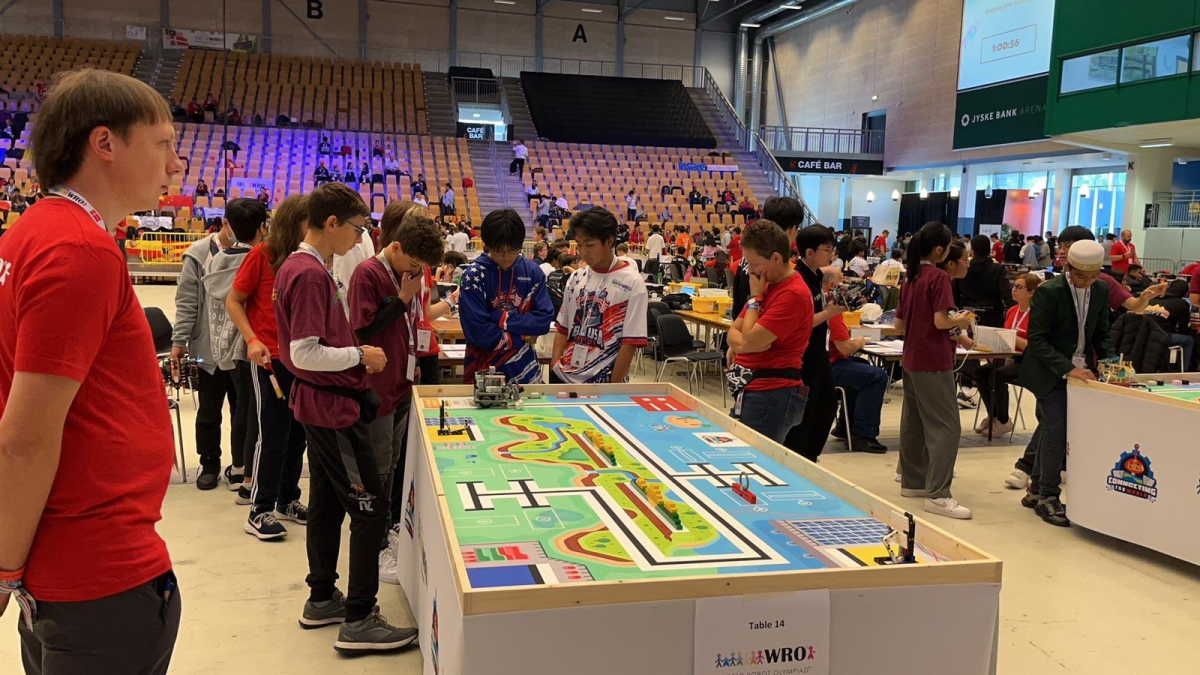William Wu and Jack Xu, both freshmen at Rancho Cucamonga High School, focus on the task at hand. They’ve been studying different robot designs for so long, and they are confident in the design they’ve chosen. As they quickly type in different codes onto the computer, they hope that this combination will be their golden key to success. The robot they’ve designed for the past few months slowly completes the different tasks coded onto the computer, and after much trial and error, they reach their glory.
The World Robot Olympiad is an annual worldwide competition where the top robotics teams from all across the globe come together to compete with each other. In the 2023 WRO, participants traveled to Oden, Denmark on Sept. 21-24 to participate in the Friendship Invitational. The theme for this year’s invitational was “Connecting the World.”
Wu and Xu were among the pool of participants at the international competition. Wu and Xu were awarded 3rd place, competing under their team name “Team JAW” (Jack And William).
According to Xu, winning in this competition gives you recognition, an award, and experience with learning how to build robots.
After applying for WRO, the two competed in a national tournament, which allowed them to compete in the international invitational. There are no prerequisites in applying for the olympiad other than having to pay an entry fee.
Xu moves on to explain how both Wu and himself first met and became friends at Day Creek Intermediate School. Xu shared his enthusiasm for robotics and how he was interested in pursuing this interest.
“I really liked robots when I was little,” Xu said. “I wanted to find a program that was able to help me build my own robot that would complete [different] tasks [I coded].”

Each of the competitors used different materials to build their robots, mainly through the use of Lego Mindstorms, which is used to help users build, code, and operate a robot.
In the Friendship Invitational, competitors were given a task by the judges in which they were to build a robot that completed certain tasks. The competition was then judged based on the way the tasks were executed and completed.
“Each team builds their own robot to complete a certain task that was given by the [judges],” Xu said. “On the competition day, [competitors] are given extra surprise rules to add onto the original task.”
Each of these projects was expected to work on a map where they move and complete their task. The judges expect the competitors to code on the spot based on the unexpected obstacles their robots face on the map.
When building their robot, Xu would go to Wu’s house to prepare and find different designs to produce a robot that will complete the tasks that were provided to them. The two would then tailor the robot to complete different tasks based on the codes.
“We would turn the robot on, test everything, then we would start running the robot,” Xu said. “Based on whatever the robot did, we would make adjustments to make it do better, either angle or program wise.”
In addition to coding on the spot during the international competition, the team had to be creative and make changes to their project based on unexpected things that happened in order to adapt to the new environment.
However, when the two brought their robot on the long trip from California to Denmark, they realized that there were some issues in the build.
“When we brought our robot to Denmark, it had issues because it was rolling around in the baggage and we had to fix that,” Wu said.
After they were able to fix the immediate problem, the team’s robot was then affected by the environment at the competition stage since the stage differed from the location they originally practiced. This meant that the robot needed to be adjusted to fit the new setting.
“The lights on the competition stage were different from when we were practicing. We have a color sensor that detects blocks: either black or white or something like that,” Wu said. “When we looked at the intensity, the lights at the competition were stronger than the lights at our testing ground. So it reflected stronger lights. The variable was wrong so we had to change that.”
On the day of the competition, judges wanted competitors to build and code a robot that identified four different objects and placed them in designated areas. Essentially, the devices needed to scan the object and determine whether they needed to put the object in one area or another.
“[The robot] sees random things and [completes tasks] according to what is there,” Wu said.
When building their own robot, Wu and Xu used two arms with a large motor to complete the task provided. Essentially, their robot scanned the object, picked it up, then placed it in its designated area.
While some teams did something similar, others had a different approach.
“[Some teams] also built the same thing. But there’s different designs to complete the tasks,” Wu said. “Some teams, instead of picking it up, they just push the [objects].”
The two explained that though they won third place, they faced different challenges throughout the competition. This was mainly because of the surprise tasks the judges announced on the day of the competition.
“We had to take the entire robot apart, and it screwed up some measurements that we had before,” Xu said. “We had to retest the entire robot [on the spot].”
However, through trial and error, Team JAW earned a third-place title and was able to push through, “putting in a lot of effort beforehand and a lot of effort during the competition,” Wu said.
This story was originally published on The Cat”s Eye on October 24, 2023.




































